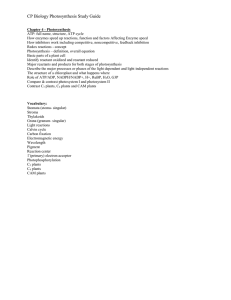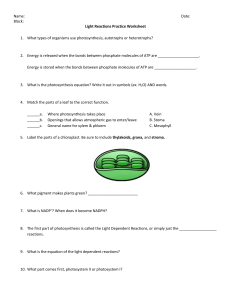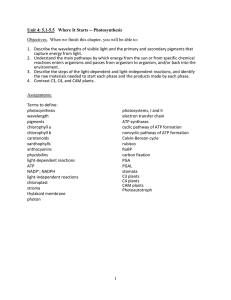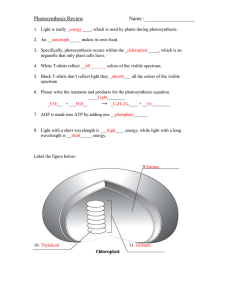Photosynthesis Chapter 8 in the Textbook
advertisement
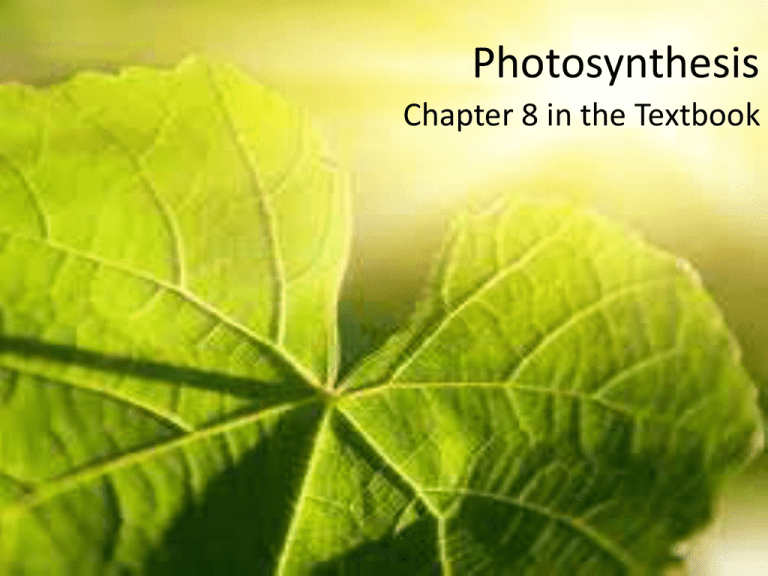
Photosynthesis Chapter 8 in the Textbook Chemical Energy and ATP • What type of organic macromolecule is shown in the diagram. • The in the diagram label the following: – Phosphate groups – Sugar – Nitrogenous Base Chemical Energy and ATP ATP (adenosine triphosphate) is the most important molecule cells use to store and release energy Energy: the ability to do work Energy comes in many different forms: • Light energy • Mechanical Energy • Chemical Energy Chemical Energy and ATP • When an organism uses the energy from ATP, the ATP is converted into ADP – ADP (Adenosine Diphosphate ) has only 2 phosphate groups. – Cells can add a phosphate to ADP to make ATP to store energy. (This requires energy) – Where do YOUR cells get the energy to convert ADP into ATP? – How is ATP and ADP similar to rechargeable batteries? What do seeds need to grow? Using scissors punch a hole in the bottom of each cup. Cup 1 (No water): Add soil and seeds. Cover the cup with plastic wrap so water cannot enter. Cup 2 (No soil): Add cotton, water and seeds. Leave the cup uncovered. Cup 3 (No Light): Add soil, water and seeds, then cover with foil to block out all light. Cup 4 (Control): Add soil, water and seeds. Leave the cup uncovered. Chemical Energy and ATP The mitochondria and the chloroplast are the most important organelles in energy transformations. • Chloroplast – Uses the energy in sunlight to create glucose – Found in the cells of plants and protists • Mitochondria – Uses the energy in glucose to convert ADP into ATP – Found in the cells of all eukaroytic organisms (including plants!!!) Chemical Energy and ATP NADPH is a molecule that has a similar function to ATP • NADPH contains chemical energy. • When the cell uses the energy, NADPH is converted into NADP+ • Energy from sunlight is necessary to convert NADP+ back into NADPH Chemical Energy and ATP How could a small seed gain enough energy to grow into seed a giant tree? Autotroph – uses energy from the sun to produce food Heterotroph – obtains energy from food it consumes Chemical Energy and ATP Light and Pigments Overall Photosynthesis Equation 6CO2 + 6H2O Carbon Dioxide Water LIGHT C6H12O6 + 6O2 Glucose Oxygen Photosynthesis: the process where plants convert energy from the sun into chemical energy stored in the bonds of carbohydrates. Light and Pigments Light Speed, c = 2.9979 x 108 m/s Or 670.6 million mph How are the two types of light different? How are they similar? Light and Pigments Electromagnetic Spectrum Wave length and energy are inversely proportional The smaller the wave length, the more energy Which type of light has more energy, the blue or the red? Explain. Light and Pigments • What colors of light are being absorbed? • What colors of light are being reflected? • What color would the object appear if there was no blue light? • Why are plants usually green? Light and Pigments • Pigments – light absorbing molecules • Chlorophyll – the most abundant pigment in plants, that absorbs blue and red light. Photosynthesis: An Overview • Photosynthesis takes place in the chloroplast – Thylakoids – saclike photosynthetic membrane in the chloroplast – Stroma - the region outside of the thylakoid membranes Photosynthesis: An Overview Photosynthesis is a complex process that can be broken down into 2 steps: The Light Reaction (The light dependent Reaction) Step 1: Photosystem II • Photosystem: a cluster or chlorophyll and proteins found in the thylakoids. • Light is absorbed by photosystem II which creates high energy electrons. • A water molecule is split to provide more electrons and hydrogen ions and oxygen is released. Step 2: Electron Transport Chain • The electrons from photosysem II move to the electron transport chain. • Electrons move from molecule to molecule to pump H+ ions from the stroma into the thylakoid space. • What type of transport is used to move the H+ ions? Explain Step 3: Photosystem I • Since the electrons used some energy pumping H+ ions they need to be renergized. • Light collected at photosystem I renergizes electrons. • The electrons along with H+ ion combine with NADP+ to from NADPH Step 4: ATP Formation • A high concentration of H+ have been pumped into the thylakoid. • The H+ “want” to move into the stroma. Why? • The only way to get to the stroma is to go through a protein called ATP Synthase. • When H+ move through ATP Synthase a ADP molecule is converted into ATP The Dark Reaction (The light independent Reaction) • The NADH and ATP from the light reaction move to the stroma. • The leaf absorbs CO2 from the atmosphere. • The energy from the NADH and ATP is used to convert CO2 into carbohydrates. • What is the main function of carbohydrates? The Dark Reaction (The light independent Reaction) • Each molecule of glucose contains enough energy to produce 36 ATP’s. • Plants produce starch when they need to store energy. • Starch is a long chain of glucose. Factors affecting Photosynthesis Water • Plants need water for photosynthesis – In the light reaction a water molecule is split apart in electrons and H+. – Electrons and H+ are needed to create NADPH and ATP • If there is not enough water – The plant will wilt because a lack or turgor pressure – The plant will stop photosynthesizing to conserve water • Can too much water harm a plant? Factors affecting Photosynthesis Temperature • The chemical reactions that occur during the light reactions and the dark reactions are all controlled by enzymes. – Too cold: photosynthesis occurs slowly because enzymes and substrate move slower. – Too hot: photosynthesis occurs slowly because enzymes begin to denature. Factors affecting Photosynthesis Light • Light intensity determines the rate of photosynthesis – The more intense the light, the faster the rate of photosynthesis. • The pigments in plant can only absorb certain wavelengths of light. – Green light is mostly reflected by chlorophyll and will not affect the rate of photosynthesis. Photosynthesis and Cell Respiration • Cell Respiration is the opposite of photosynthesis. – What is the equation for photosynthesis? – What is the equation for respiration. – Respiration breaks down carbohydrates into ATP. Photosynthesis and Cell Respiration • Plants perform both photosynthesis and respiration. – Think: It would pointless to make carbohydrates if you did not break them down into energy.


